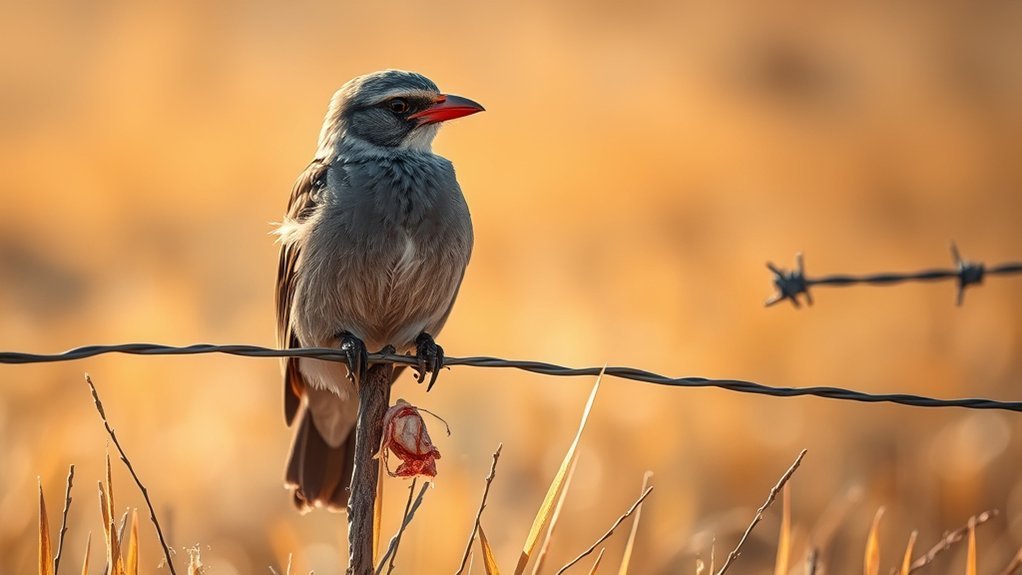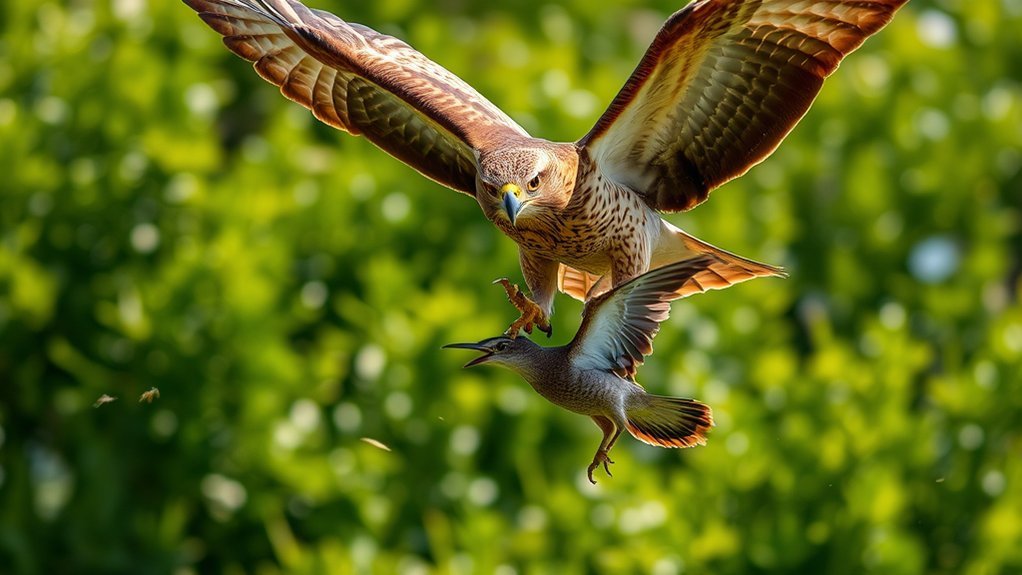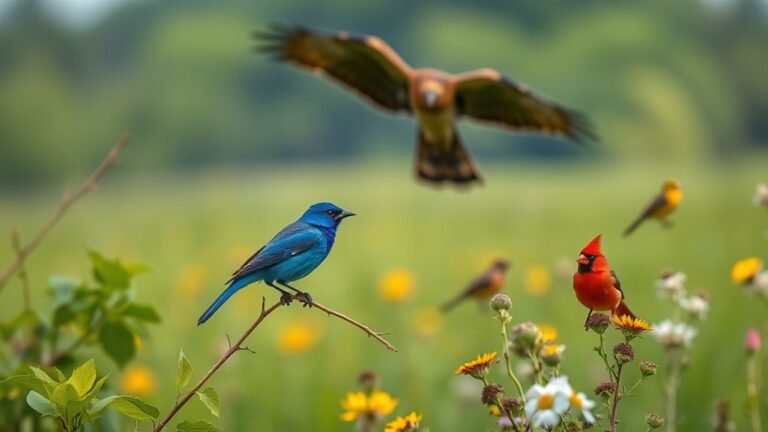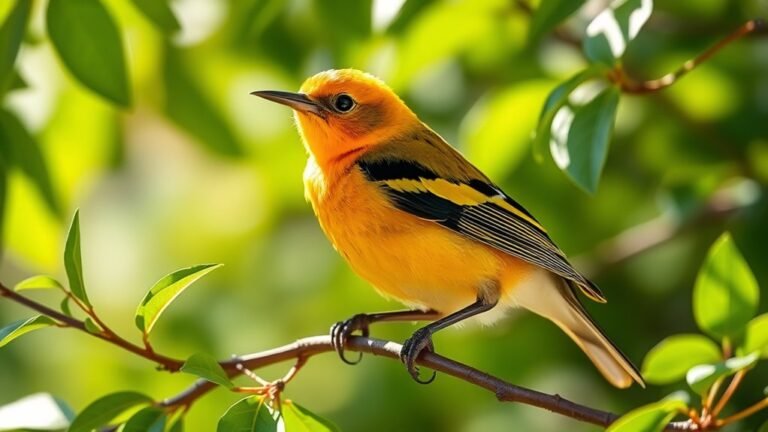Birds That Eat Other Birds: A Look at Predatory Behavior
When you look up at the sky, you might see birds flying around. Some of these birds are hunters. They include the sharp-shinned hawk, which is quick, and the peregrine falcon, which is strong. These birds have special skills that help them catch other birds. Each type of bird has its own way of hunting. They use both their cleverness and their instincts to find food.
But why do these birds hunt? What do they mean for nature? Let's take a closer look at these amazing birds and how they fit into our environment.
A Quick Overview
Some birds hunt and eat other birds. These hunting birds are called birds of prey. They have special features like sharp claws and curved beaks that help them catch their food.
Fast birds like hawks and peregrine falcons rely on speed to catch smaller birds in the air. They can zoom in quickly and snatch their meals. Eagles have amazing eyesight. They can see far away and spot their next meal from high up in the sky.
Sadly, many hunting birds are losing their homes because cities are growing. This makes it hard for them to find food and can cause their numbers to drop. When their populations decline, it affects the balance of nature.
Learning about these birds and how they hunt shows how important they are to our ecosystem. Protecting them is essential, so they can continue to play their role in nature.
The Evolution of Avian Predators

As you learn about birds of prey, you'll see how their changes over time help them hunt better.
Birds like eagles and hawks have special traits that make them great hunters. For example, they've sharp claws and curved beaks that help them grab and eat their food easily.
These birds also have amazing eyesight. They can spot a meal from far away, which helps them catch it faster. Plus, they can fly really fast, making it easier to chase smaller birds.
By understanding how these birds have changed over many years, you can see how they fit into nature. Each one plays an important role in its environment.
Common Birds That Hunt Other Birds
Many birds hunt other birds. These hunters are called birds of prey. You can see them while birdwatching. Look for sharp-shinned hawks and Cooper's hawks. They fly fast and are very quick. They like to chase smaller birds.
When the seasons change, you might spot peregrine falcons too. They dive down quickly when hunting, which looks amazing. Watching these birds shows how different and interesting our nature is.
If you want to see these skilled hunters, visit urban parks or woodlands. Bring binoculars to watch them closely.
Stay quiet and patient. You might see a thrilling moment when a bird catches its meal. This can help you appreciate nature even more.
Hunting Techniques of Predatory Birds

Watching birds of prey chase their food is exciting. These incredible hunters use smart tricks to catch their meals. For example, falcons dive quickly to surprise their prey. Eagles have strong eyes that help them spot weak birds from way up high.
Some birds, like osprey, plan their attacks carefully. They swoop down quietly to get the best chance of catching something.
Other birds, like merlins, are very agile and move quickly, making it hard for their prey to escape.
Each bird uses their special abilities and understands their surroundings well. This helps them stay effective hunters, playing an important role in nature's balance.
The Role of Raptors in Ecosystems
Raptors, like hawks and eagles, help keep nature in balance. They hunt smaller birds and animals. This keeps these populations from growing too big and harming their homes.
Raptors aren't just good at hunting; they also help recycle nutrients in nature. This means they make sure the environment stays healthy. When you see a hawk flying high or an eagle on a tree branch, you're seeing how nature works perfectly.
Learning about raptors can help you appreciate wildlife more. You can also support efforts to protect these amazing birds and the places they live.
Enjoying nature and caring for it go hand in hand!
Shrikes: The Butcher Birds

Shrikes are fascinating birds known as butcher birds because of their special hunting skills. They aren't like the usual songbirds. Shrikes have sharp beaks and great eyesight, which help them catch insects and small birds with ease.
What really makes shrikes unique is their strange way of storing food. They often stab their prey onto thorns or pieces of barbed wire. This helps them save their meals for later. It's a clever way to secure their food and shows how smart they are.
If you watch these birds in action, you'll see how well they've adapted to their surroundings. Their hunting techniques are impressive, and they're truly remarkable creatures.
Avian Cannibalism: An Unusual Behavior
Many birds have interesting ways of finding food, but some engage in a surprising behavior called avian cannibalism. This means they sometimes eat other birds, even their own kind. It might sound shocking, but they do this for some clear reasons:
- Need for food: When times are tough, birds may have to eat their own family members to survive.
- Claiming territory: Some birds eat others to secure their home and show they're in charge.
- Controlling population: By reducing the number of other birds, they help their own babies have enough food.
- Stress situations: Even birds that look healthy can eat others when food gets scarce.
Knowing why birds sometimes act this way helps us understand their lives better. It shows us how survival can lead to unexpected actions in nature.
Nest Predation: A Threat to Nesting Birds
As you learn about birds and their survival, you'll see that nest predation is a big danger for them. Many birds work hard to keep their eggs and babies safe. They pick hidden spots for their nests or build them in special ways.
But sometimes, these plans don't work because of hungry animals.
Adult birds often try to protect their nests. They make alarm calls to warn other birds or play tricks to lead predators away.
Even with these efforts, clever animals like crows and snakes can still find their nests and cause trouble.
Knowing about these threats helps us see how amazing these birds are. They go to great lengths to keep their young safe in a tough world where predators are always on the lookout.
The Impact of Urbanization on Avian Predators
Urbanization changes how birds of prey live. As cities grow, these birds adjust to new areas for hunting and nesting. They face new challenges but also find new chances.
You can see them in:
- Tall buildings that help them spot their food.
- Parks that offer safe places for nesting.
- Roads and highways that can block them but also allow easy access to their prey.
- Trash bins, where they find extra food.
These changes show how adaptable these birds can be. However, urban environments can be tricky for them.
Learning about these changes helps us understand more about how cities and birds interact. This can deepen our connection with nature in our changing world.
Conservation Challenges for Predatory Birds
Predatory birds are amazing to watch, especially in cities. But did you know they face big problems? Many of these birds lose their homes because of building and development. They need places to nest and hunt, and urban growth takes away their natural habitats.
Their food is also getting scarce. With fewer birds and small animals to catch, these predators find it hard to eat enough. This situation doesn't just affect them; it harms the entire ecosystem. Each bird helps keep the environment healthy, and when they struggle, it hurts nature around us.
We can help! By supporting efforts to protect these birds, we ensure they can continue to fly above us. They connect our city lives with nature, and we can play a part in keeping that connection strong.
Let's make sure these beautiful birds have what they need to thrive!
Fascinating Facts About Bird Predators
Have you ever thought about how amazing predatory birds are?
They're smart and have cool ways to hunt. Let's look at some fun facts about them:
- Kestrels can hover in the air. They look around carefully for food.
- Bald eagles have sharp eyesight. They can see fish from over a mile away!
- Falcons are super fast. They can dive at over 200 mph, making them the fastest birds on Earth.
- Great horned owls can fly silently. This helps them sneak up on their prey without being noticed.
These amazing abilities show how skilled these birds are at hunting.
It also helps us appreciate nature more.
Isn't it great to share our world with such wonderful creatures?
There's always something new to learn about them!
Frequently Asked Questions
Are There Non-Raptor Birds That Also Eat Other Birds?
Some birds that are not raptors also eat other birds. For example, sparrow hawks can catch smaller birds. Crows are another example; they often hunt and eat other birds too. These behaviors show how birds can adapt to find food. It's interesting to see how different types of birds interact with each other, especially when they are both looking for a meal.
How Do Environmental Changes Affect Bird Predation Behavior?
Environmental changes, like climate change and habitat loss, make food harder to find for birds. In response, birds change how they hunt. They might look for food in new places or change what they eat to adapt to their new surroundings. These changes help them survive in different environments.
Birds are smart and can adjust quickly to find what they need. Sometimes, they have to search farther away or try new foods they haven't eaten before. This ability to adapt is important for their survival. Understanding how birds change their hunting habits can help us see how they react to the changes happening in their habitats.
What Defense Mechanisms Do Smaller Birds Use Against Predators?
Smaller birds use several clever tricks to stay safe from predators. One way they protect themselves is by blending in with their surroundings. This means they have colors and patterns that help them disappear among the leaves or grass.
Another way these birds stay safe is by making alarm calls. When one bird spots a danger, it makes a loud sound to warn others nearby. This helps them alert their friends and increases their chances of escaping from the threat together.
How Do Human Activities Impact Bird Predator-Prey Dynamics?
Human activities change how birds hunt and interact with their environment. When people build houses or cut down trees, birds lose their homes. This makes it harder for them to find food and thrive. When bird populations drop, it affects other animals and plants around them. In short, our actions can disturb nature and make it less beautiful. It's important to remember that the health of birds helps keep our ecosystem balanced.
Can Birds Develop Hunting Skills Through Social Learning?
Yes, birds can learn to hunt by watching other birds. When they see skilled hunters in action, they copy their moves. This helps them get better at catching food and staying alive in nature. Social learning makes hunting easier for them. It's fascinating to see how they pick up skills just by watching!

Luna is the passionate founder and author of Birds and You, a website dedicated to sharing her love for birds with fellow enthusiasts. Through her engaging articles and guides, she aims to educate and inspire others to explore the fascinating world of birds. When she’s not writing, you can find Luna observing birds in their natural habitats or sharing beautiful bird photography on Pinterest. Join her on this journey to celebrate and protect our feathered friends!







